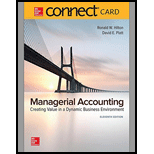
Connect 1-Semester Access Card for Managerial Accounting: Creating Value in a Dynamic Business Environment (NEW!!)
11th Edition
ISBN: 9781259727788
Author: Hilton & Platt
Publisher: MCG
expand_more
expand_more
format_list_bulleted
Question
Chapter 17, Problem 36C
1.
To determine
Draw a diagram that portrays the joint production process of Company V.
2.
To determine
Allocate the joint production costs of company V for the month of May under the following methods:
- a. The physical-units method.
- b. The relative-sales-value method.
- c. The net-realizable-value method.
3.
To determine
Describe whether Kryptite should be processed further into Omega and if so state the reason.
4.
To determine
Describe whether the joint cost allocation from requirement (2) is used or not in requirement (3) and explain the reason behind it.
5.
To determine
Prepare an excel sheet for the given detail in requirement (2) and (3), assume that the joint cost is $245,000, and the sales price of Omega is $125 per pound.
Expert Solution & Answer
Want to see the full answer?
Check out a sample textbook solution
Students have asked these similar questions
Expert of Account Solve this asap
Please explain the solution to this general accounting problem using the correct accounting principles.
Please give me answer with accounting question
Chapter 17 Solutions
Connect 1-Semester Access Card for Managerial Accounting: Creating Value in a Dynamic Business Environment (NEW!!)
Ch. 17 - Prob. 1RQCh. 17 - Prob. 2RQCh. 17 - Should actual or budgeted service department costs...Ch. 17 - Prob. 4RQCh. 17 - Why does dual cost allocation improve the...Ch. 17 - What potential behavioral problem can result when...Ch. 17 - Should actual or budgeted service department costs...Ch. 17 - Explain the difference between two-stage...Ch. 17 - Define the following terms: joint production...Ch. 17 - Prob. 10RQ
Ch. 17 - Describe the relative-sales-value method of joint...Ch. 17 - Define the term net realizable value, and explain...Ch. 17 - Are joint cost allocations useful? If they are,...Ch. 17 - For what purpose should the managerial accountant...Ch. 17 - Prob. 15ECh. 17 - Refer to the data given in the preceding exercise....Ch. 17 - Tuscaloosa National Bank has two service...Ch. 17 - Refer to the data given in the preceding exercise....Ch. 17 - Breakfasttime Cereal Company manufactures two...Ch. 17 - Refer to the data given in the preceding exercise....Ch. 17 - Refer to the data given in Exercise 1720....Ch. 17 - Prob. 23ECh. 17 - Prob. 24PCh. 17 - Prob. 25PCh. 17 - Celestial Artistry Company is developing...Ch. 17 - Snake River Sawmill manufactures two lumber...Ch. 17 - Travelcraft Company manufactures a complete line...Ch. 17 - Biondi Industries is a manufacturer of chemicals...Ch. 17 - Berger Company manufactures products Delta, Kappa,...Ch. 17 - Prob. 31PCh. 17 - Lafayette Company manufactures two products out of...Ch. 17 - Refer to the data given in Problem 1726 for...Ch. 17 - Prob. 34PCh. 17 - Top Quality Fruit Company, based on Oahu, grows,...Ch. 17 - Prob. 36C
Knowledge Booster
Similar questions
- What was her capital gains yield?arrow_forwardBeethoven Corp. had net sales of 45,600 and ending accounts receivable of 5,700 for the current period. Its days' sales uncollected equals: (Use 365 days a year.) a. 40.25 days b. 36.17 days c. 45.63 days d. 32.43 days e. 30.47 days HELParrow_forward??!!arrow_forward
- Solve thisarrow_forwardThe stock of UCD has just been sold in an initial public offering at a price of $165 per share. One week after this offering, the stock has risen to $195. You believe the stock will rise to $225 over the coming year. You expect UCD to pay a $15 dividend during the coming year. If you require a rate of return of 30%, do you believe this is a good investment at the current price of $195? a. Yes, the holding period return is 33.33% greater than 30%. b. No, the holding period return is 25.64% less than 30%. c. No, the holding period return is 23.08% less than 30%. d. No, the holding period return is 15.38% less than 30%.arrow_forwardCompute the amount of raw materialsarrow_forward
- I need help with this general accounting question using the proper accounting approach.arrow_forwardPinnacle Inc. reported an increase of $290,000 in its accounts receivable during the year 2022. The company's statement of cash flows for 2022 reported $860,000 of cash received from customers. What amount of net sales must Pinnacle have recorded in 2022?arrow_forwardA new machine with a purchase price of $90,000, transportation costs of $8,000, installation costs of $6,000, and special handling fees of $2,000, would have a cost basis of___. a. $106,000 b. $110,000 c. $108,000 d. $102,000arrow_forward
arrow_back_ios
SEE MORE QUESTIONS
arrow_forward_ios
Recommended textbooks for you
 Cornerstones of Cost Management (Cornerstones Ser...AccountingISBN:9781305970663Author:Don R. Hansen, Maryanne M. MowenPublisher:Cengage Learning
Cornerstones of Cost Management (Cornerstones Ser...AccountingISBN:9781305970663Author:Don R. Hansen, Maryanne M. MowenPublisher:Cengage Learning Managerial AccountingAccountingISBN:9781337912020Author:Carl Warren, Ph.d. Cma William B. TaylerPublisher:South-Western College Pub
Managerial AccountingAccountingISBN:9781337912020Author:Carl Warren, Ph.d. Cma William B. TaylerPublisher:South-Western College Pub Financial And Managerial AccountingAccountingISBN:9781337902663Author:WARREN, Carl S.Publisher:Cengage Learning,
Financial And Managerial AccountingAccountingISBN:9781337902663Author:WARREN, Carl S.Publisher:Cengage Learning,

Cornerstones of Cost Management (Cornerstones Ser...
Accounting
ISBN:9781305970663
Author:Don R. Hansen, Maryanne M. Mowen
Publisher:Cengage Learning

Managerial Accounting
Accounting
ISBN:9781337912020
Author:Carl Warren, Ph.d. Cma William B. Tayler
Publisher:South-Western College Pub

Financial And Managerial Accounting
Accounting
ISBN:9781337902663
Author:WARREN, Carl S.
Publisher:Cengage Learning,